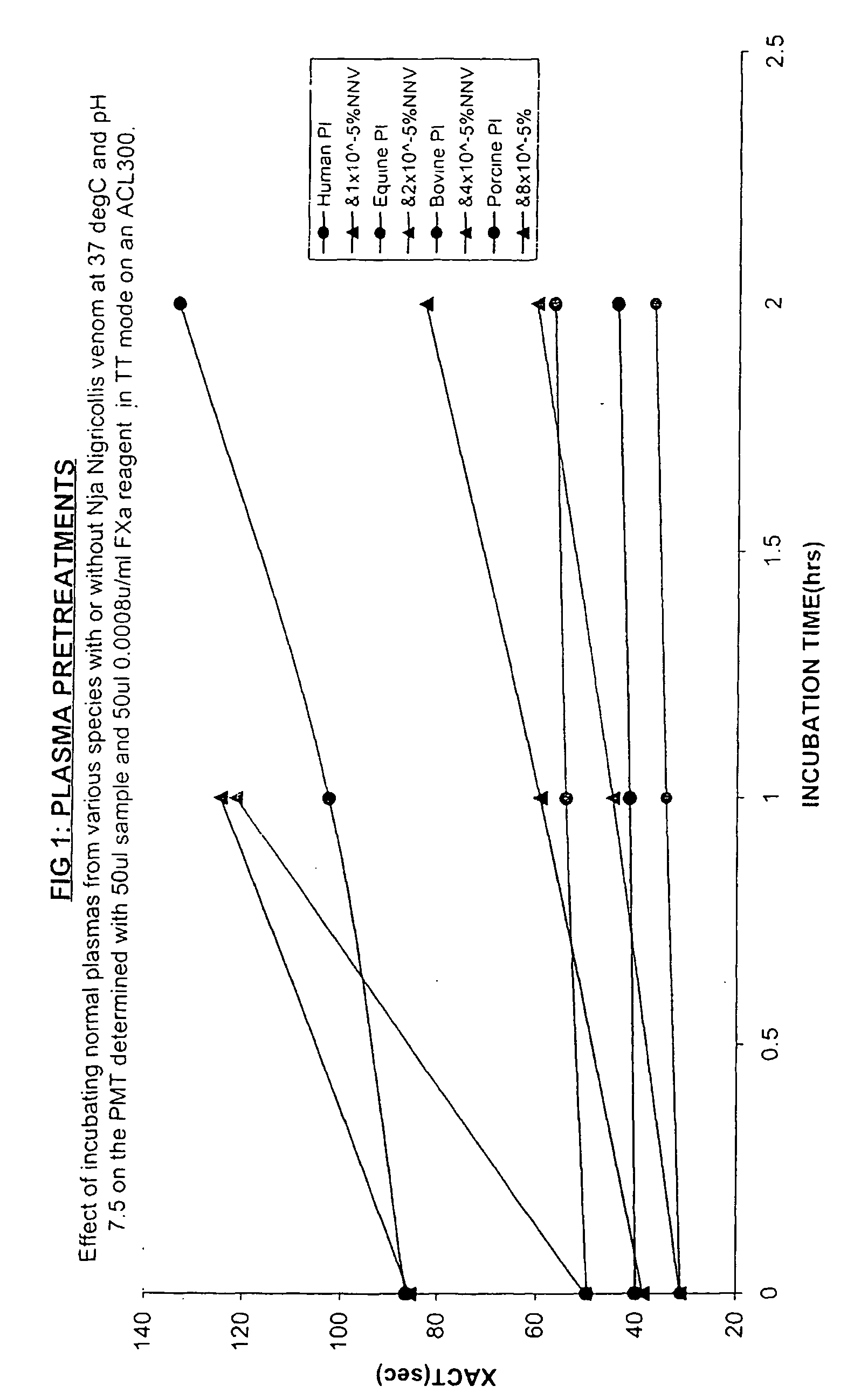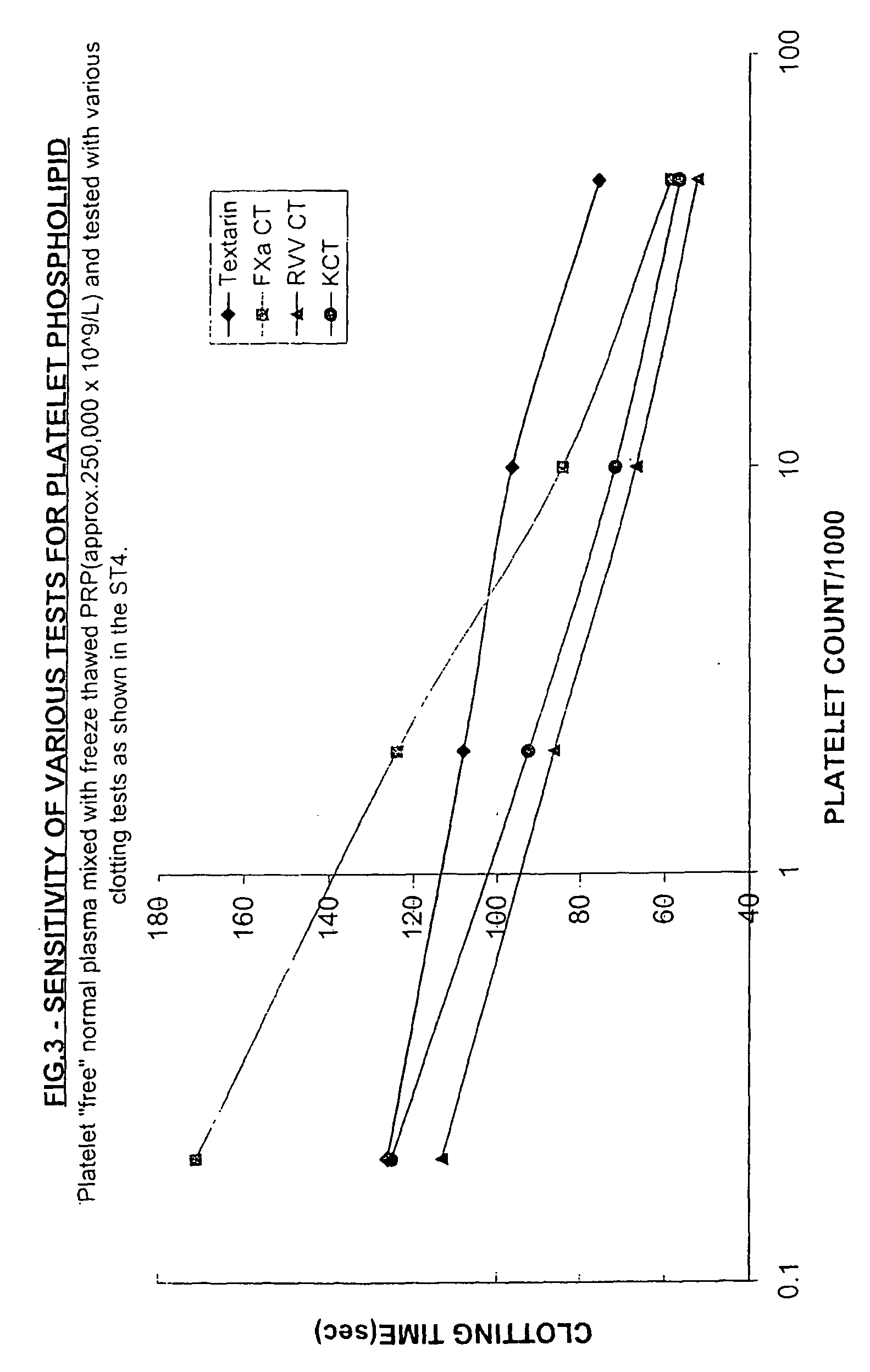Method for detecting procoagulant phospholipid
a procoagulant and phospholipid technology, applied in biochemistry apparatus and processes, pulse automatic control, enzymemology, etc., can solve the problems of inconvenient acquisition, difficult control of the depletion of procoagulant phospholipid from the substrate plasma, and insufficient platelet activation in certain bleeding, so as to improve coagulability and inhibit coagulation
- Summary
- Abstract
- Description
- Claims
- Application Information
AI Technical Summary
Benefits of technology
Problems solved by technology
Method used
Image
Examples
example 1
Progressive Effect of N Nigricollis Venom on Crude Animal Plasmas
[0055] Aim: To demonstrate the progressive and selective effect of a typical venom phospholipase in reducing the procoagulant phospholipid from platelet-containing plasmas from various species, thereby improving the sensitivity of those substrate plasmas in clotting tests for procoagulant phospholipid.
[0056] Method: Blood samples were collected into one tenth its final volume of 3.2% trisodium citrate anticoagulant by clean venipuncture from a human volunteer, by cardiac puncture from a freshly shot horse (equine), by an arterial bleed from a pig at an abattoir and similarly from an ox (bovine). The samples were centrifuged at 3,000 rpm for 20 minutes is and the supernatant platelet poor plasmas with quite variable platelet counts (approximately 5×109 / L for the human sample, but not measured for the animal plasmas) were frozen at −30° C.
[0057] Subsequently thawed platelet poor samples were incubated at 37° C. withou...
example 2
Pretreatment of Human Plasma with N Nigricollis Venom.
Aim: To show that treatment of a normal human plasma with a trace of N nigricollis venom gives a product (substrate plasma) with better sensitivity to platelets in a Factor Xa-based clotting test than centrifugation.
[0060] Method: Test plasmas containing varying levels of freeze-thawed normal platelet rich plasma (PRP initially with 250×109 platelets / L) in platelet “free” normal human plasma were prepared. The platelet free plasma (PFP) was obtained by high speed centrifugation and filtration through a 0.22 micron syringe filter.
[0061] These test plasmas were mixed with an equal volume of 3 different substrate plasmas before being tested in a factor Xa-based clotting test. The 3 different substrate plasmas were:
[0062] 1. Normal platelet “poor” human plasma (PPP).
[0063] 2. The same PPP centrifuged at 15,000g for 10 min.
[0064] 3. The same PPP treated with 1×10−5% N nigricollis venom for 20 minutes at 37° C. (hereinafter the ...
example 3
Effect of a Pre-Treatment with N Nigricollis Venom on Platelet Sensitivity
Aim: To demonstrate the effect of N nigricollis venom in enhancing the sensitivity of a Russells viper venom clotting test system based on bovine plasma.
[0067] Method: A series of dilutions of a frozen-thawed, though otherwise normal human platelet rich plasma (with initial platelet count of 250×109 / L) were made in normal bovine plasma and also in bovine plasma pretreated for 50 min at 20° C. with 5×10−5% N nigricollis venom. These plasma samples were mixed with an equal volume of various Russell's viper venom and calcium-containing reagents and timed to a clotting endpoint at 37° C. in thrombin time mode (TT mode uses equal volumes of plasma and reagent) in a ACL300 clot-timing instrument (Instrumentation Laboratory SpA, Milan, Italy). The Russell's viper venom concentration in the reagent with 0.025 M calcium chloride was varied from 10−5% to 10−6% and the former reagent was also tested after the addition...
PUM
| Property | Measurement | Unit |
|---|---|---|
| clotting time | aaaaa | aaaaa |
| clotting time | aaaaa | aaaaa |
| clotting time | aaaaa | aaaaa |
Abstract
Description
Claims
Application Information
 Login to View More
Login to View More - R&D
- Intellectual Property
- Life Sciences
- Materials
- Tech Scout
- Unparalleled Data Quality
- Higher Quality Content
- 60% Fewer Hallucinations
Browse by: Latest US Patents, China's latest patents, Technical Efficacy Thesaurus, Application Domain, Technology Topic, Popular Technical Reports.
© 2025 PatSnap. All rights reserved.Legal|Privacy policy|Modern Slavery Act Transparency Statement|Sitemap|About US| Contact US: help@patsnap.com



